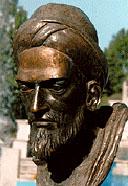 Sa’di was the pen name for the Persian poet Saadi Shirazi who is considered one of the major regional writers from the 13th Century and is notable that number of his works have been popularized in the West. Sa’di was born into a relatively poor family and his time living in Shiraz in Iran was difficult, made more so by the early death of his father.
Sa’di was the pen name for the Persian poet Saadi Shirazi who is considered one of the major regional writers from the 13th Century and is notable that number of his works have been popularized in the West. Sa’di was born into a relatively poor family and his time living in Shiraz in Iran was difficult, made more so by the early death of his father.
The poverty of his youth forced Sa’di to move to Baghdad in search of a better chance in life. He entered Nizamiyya University and began studying Islamic law and science as well as the literature of the region. Much of our knowledge of his life, of course, comes from an examination of his poetry and it gives a deep insight into the times and people. When he had finished his studies Sa’di began a period of thirty or so years traveling from place to place.
These were unsettled times for the area with the invasion by the Mongols and battles with Crusaders who had come across from Europe. In Halab, Sa’di joined in a battle against the Crusaders and was captured at Acre and then spent 7 long years in hard labor for his troubles. He wasn’t freed until a ransom was paid for prisoners by the Mamluks.
After his release, Sa’di continued on his travels, visiting Jerusalem and from there he went on a pilgrimage to Mecca. With the Mongol invaders still causing problems, he lived much of his time hand to mouth, coming across wandering caravans of people who were running for their lives – something which he chronicled in his poetry.
Unlike many of the great writers of his time, Sa’di spent little time mingling in the great courts and preferred to spend his life amongst the kind of people he had grown up with. The effect of the Mongol invasions and the Crusades meant that he came across a wide variety of people who had been displaced, from common bandits to once powerful imams and rich merchants.

His most famous work is The Orchard which is a complete set of verses exploring Islamic tenets such as justice and modesty. His other well-known publication is The Rose Garden which is a collection of stories from the people he met on his travels and verses that contain meaningful sayings and humor.
Sa’di wrote mostly in Persian though his works are also found in Arabic. His aphorisms were widely popular at the time and perhaps the most famous one is Bani Adam that has been translated into a variety of English versions.

His work is often split between spiritual musings and descriptions of the everyday existence of the population around him, and his style was simple rather than being hidden behind complex imagery and he is still widely read in the Arabic world today.
Despite the fact that Sa’di’s life was one spent largely on the road moving from place to place, he was thought to have lived to a good age. He died around 1291 when he would have been in his eighties.

